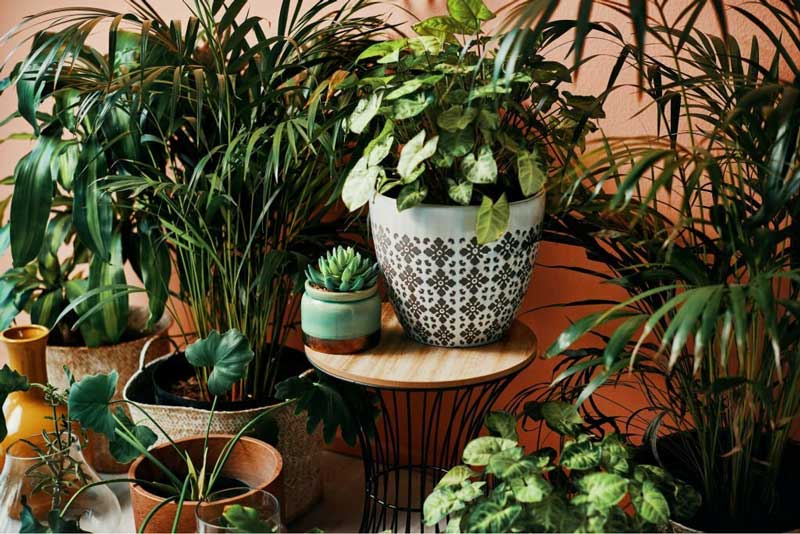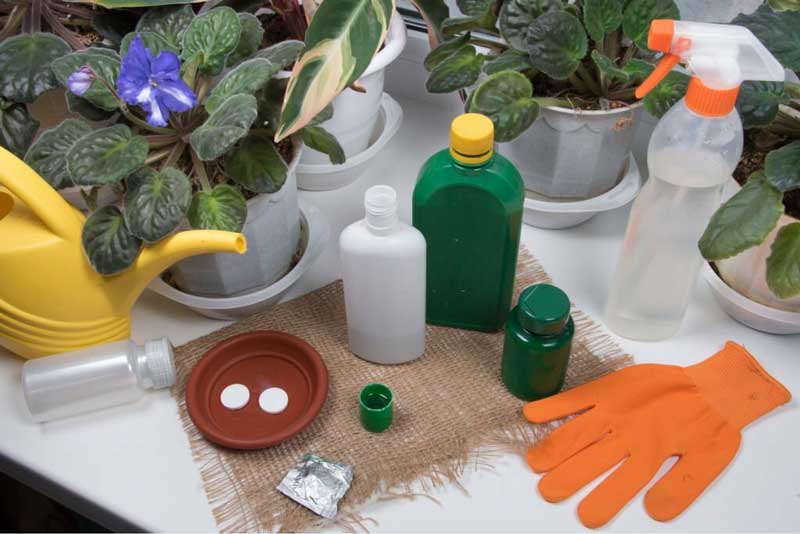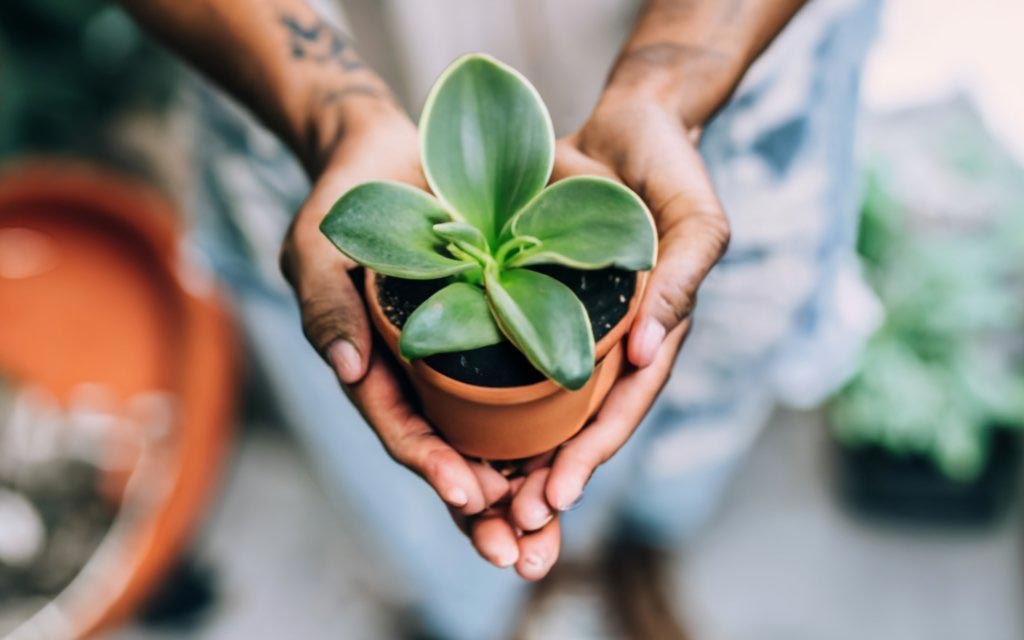To take care of indoor plants without sunlight, provide them with artificial light sources such as grow lights or fluorescent bulbs.
In this article, we will discuss the best ways on how to take care of indoor plants without sunlight, including some factors you must consider, reasons why you need it, and others.
Reasons Why Indoor Plants Without Sunlight Are Essential For Your Home Or Office
Indoor plants are not only captivating additions to any space, but they also offer numerous benefits that can enhance the well-being and productivity of those around them. While many plants thrive in natural sunlight, there are several species that can flourish with minimal sunlight or even in shaded areas.
These plants play a crucial role in improving the overall atmosphere of your home or office, and here’s why:
Increase Oxygen Levels
One of the most significant advantages of indoor plants without sunlight is their ability to increase oxygen levels in your environment. Through the process of photosynthesis, plants convert carbon dioxide into oxygen, providing a fresh and revitalizing atmosphere. By strategically placing these plants in your space, you can create a healthier and more energetic environment for everyone.
Improve Air Quality
Poor air quality can have adverse effects on both physical health and mental well-being. Thankfully, indoor plants without sunlight can act as natural air purifiers. They absorb toxins and pollutants from the air, including volatile organic compounds (VOCs) emitted from furniture, carpets, and cleaning products.
By incorporating these plants into your home or office, you can combat the harmful effects of indoor air pollution and create a cleaner and healthier environment for everyone to enjoy.
Reduce Stress And Boost Mood
Feeling stressed or overwhelmed at work or home? Indoor plants without sunlight can provide a calming effect, reducing stress levels and boosting your mood. Studies have demonstrated that merely being around plants can induce feelings of tranquility and relaxation. The presence of greenery can help you unwind, destress, and promote a sense of peace within your surroundings.
Enhance Productivity And Focus

When it comes to productivity and focus, indoor plants without sunlight can offer significant benefits. Research has found that having plants in your workspace can increase concentration, cognitive function, and productivity levels. The visual appeal of plants can help reduce mental fatigue, improve attention span, and even enhance creativity. By incorporating these plants into your workspace, you can create an environment that promotes focus and efficiency.
Overall, indoor plants without sunlight are essential for your home or office as they increase oxygen levels, improve air quality, reduce stress, boost mood, and enhance productivity, and focus. The benefits they provide go beyond their aesthetic appeal, making them a valuable addition to any space. Whether you have access to direct sunlight or not, these plants can thrive and bring numerous advantages to your indoor environment.
Factors To Consider When Selecting Indoor Plants Without Sunlight
There are some crucial factors that you must consider before selecting indoor plants. If you are interested, learn how to care for your indoor plants, especially in spaces with limited sunlight, following the tips in taking care of indoor plants for beginners.
Low light tolerance
One of the primary considerations when choosing indoor plants that can thrive without direct sunlight is their low light tolerance. Not all plants are designed to flourish in dimly lit areas, so it is essential to opt for varieties that can adapt well to low-light environments.
Plants with low light tolerance are better equipped to utilize the available light efficiently and sustain their growth. Some excellent options to consider are snake plants, peace lilies, and pothos.
Watering requirements
Another crucial factor to keep in mind when caring for indoor plants without sunlight is their specific watering needs. While some plants prefer a higher level of hydration, others require less frequent watering.
By understanding the watering requirements of your chosen plants, you can provide them with the optimal amount of moisture they need to thrive in a low-light environment. Overwatering can lead to root rot and other problems, so it’s vital to find a balance that suits your plant’s needs.
Maintenance level
Different indoor plants without sunlight have varying levels of maintenance required for their well-being. Some plants are resilient and can handle occasional neglect, while others demand more frequent attention.
Before making a selection, it’s crucial to evaluate your time and commitment availability for plant care. Assess whether you prefer low-maintenance varieties that require minimal upkeep or are willing to put in extra effort for plants that demand more attention.
Aesthetics and personal preference
Lastly, aesthetics and personal preference play a significant role in selecting indoor plants without sunlight. While considering their adaptability and care requirements, it’s essential to choose plants that align with your personal taste and complement your indoor space.
The appearance and style of your plant can greatly enhance the ambiance of your home or office. Whether you prefer lush foliage, colorful blooms, or unique shapes, there is a wide range of indoor plants to suit every aesthetic preference.
Description And Care Tips For The Best Indoor Plants Without Sunlight
Indoor plants can add beauty, freshness, and a touch of nature to any space. However, not all indoor plants thrive in low-light conditions.
If you have a room in your home or office that lacks natural sunlight, don’t worry! There are several types of plants that can still grow and flourish without direct sunlight.
Snake Plant (sansevieria)
Snake plants, also known as Sansevierias, are resilient and low-maintenance plants that can adapt well to low-light conditions. Their long, upright leaves with variegated patterns make them visually appealing and a great addition to any room.
Snake plants only need sporadic watering, so it’s important not to overwater them. They are excellent air purifiers and can thrive in various indoor environments.
- Resilient and low-maintenance
- Can tolerate low light conditions
- Water sparingly
ZZ Plant (zamioculcas Zamiifolia)
The ZZ plant, scientifically known as Zamioculcas zamiifolia, is a popular choice for indoor spaces without sunlight. Its glossy, dark green leaves add a touch of elegance to any room.
The ZZ plant is highly adaptable and thrives in low-light environments. It doesn’t require frequent watering, making it a low-maintenance option for busy plant owners.
- Thrives in low-light environments
- Requires infrequent watering
- Adds a touch of elegance to any space
Pothos (epipremnum Aureum)
Pothos, also known as Epipremnum aureum, is a versatile and adaptable plant that can tolerate low light conditions with ease. Its heart-shaped, trailing leaves make it an attractive choice for hanging baskets or as a trailing plant on shelves.
Pothos is not only aesthetically pleasing, but it is also easy to propagate and care for, making it suitable for beginners.
- Versatile and adaptable
- Can tolerate low light conditions
- Easy to propagate and care for
Peace Lily (spathiphyllum)
The peace lily, scientifically known as Spathiphyllum, is an excellent choice for indoor spaces with low light conditions. This plant is not only visually appealing with its elegant white flowers but it is also known for its air-purifying qualities.
Peace lilies require regular watering, ensuring their soil remains consistently moist. They can thrive in areas where direct sunlight is limited.
- Known for its air-purifying qualities
- Thrives in low-light areas
- Requires regular watering
Dracaena (dracaena Spp.)
Dracaena plants are available in various sizes and shapes, making them a versatile choice for indoor spaces without sunlight. Whether you prefer tall and slender or short and bushy plants, there is a dracaena species that will suit your preferences.
They can tolerate low light conditions and require moderate watering, ensuring the soil doesn’t dry out completely.
- Comes in various sizes and shapes
- Can tolerate low light conditions
- Moderate watering frequency required
Essential Guidelines To Ensure The Health And Longevity Of Your Indoor Plants Without Sunlight
Indoor plants can instantly elevate the aesthetic appeal of any space while also providing numerous health benefits. However, not all indoor areas receive ample sunlight to support the growth of plants. But fret not! With the right care and attention, you can still maintain lush and thriving indoor plants even without direct sunlight.
Proper Watering Techniques
Watering your indoor plants correctly is crucial, especially when they are not exposed to sunlight. Overwatering can lead to root rot and other fungal diseases, while underwatering can cause the plants to wilt and die. To strike the perfect balance, follow these proper watering techniques:
- Check the moisture level: Before watering your plants, check the moisture level of the soil by touching it. If the top inch feels dry, it’s time to water.
- Water thoroughly: When watering, ensure that the water reaches the bottom of the pot. This helps in encouraging the roots to grow downwards.
- Avoid water stagnation: Ensure proper drainage by choosing pots with drainage holes. Excess water should be able to flow out easily without causing waterlogging.
- Set a watering schedule: Establish a regular watering routine based on the specific needs of your indoor plants. Some plants might require more frequent watering, while others may require less.
Choosing The Right Soil And Containers
The soil and container you choose for your indoor plants play a vital role in their overall health. Here are some pointers to guide your selection:
- Well-draining soil: Opt for well-draining soil that allows excess water to flow through easily. This helps in preventing waterlogging and root rot.
- Organic matter: Choose soil that is rich in organic matter, as it provides essential nutrients to your plants.
- Container size: Select containers that are appropriate in size for your indoor plants. Too small pots can restrict root growth, while excessively large pots can lead to overwatering.
- Consider self-watering containers: If you have a busy schedule or tend to forget watering, self-watering containers can be a convenient option. These containers have built-in water reservoirs that slowly release water to the plant as needed.
Providing Adequate Humidity
Indoor environments are often drier than the natural habitat of many plants, which can affect their growth. Maintaining optimal humidity levels is vital for their well-being. Here’s how you can provide adequate humidity:
- Misting: Regularly mist the leaves of your indoor plants with a spray bottle filled with water. This helps in simulating humidity and prevents the leaves from drying out.
- Pebble tray: Place a tray filled with water and pebbles near your plants. As the water evaporates, it increases the surrounding humidity.
- Humidifier: Invest in a humidifier to maintain consistent humidity levels. This is particularly beneficial if you have several indoor plants or if your living space tends to be dry.
Regular Dusting And Cleaning
Dust accumulation on the leaves of your indoor plants can hinder their ability to photosynthesize. Regular dusting and cleaning are essential to ensure healthy growth. Follow these guidelines for proper plant maintenance:
- Gently wipe leaves: Using a soft, damp cloth or sponge, wipe the dust off the leaves. Be careful not to rub too hard or damage the foliage.
- Trim yellow or dying leaves: Remove any yellow or dying leaves to maintain the plant’s overall health and appearance.
- Clean the pot and saucer: Occasionally, clean the pots and saucers to prevent the buildup of dirt and pests. Use a mild detergent and warm water to clean them thoroughly.
- Avoid chemical cleaners: Refrain from using chemical cleaners on your plants, as they can be harmful. Stick to natural methods for cleaning and maintenance.
By following these essential guidelines, you can effectively care for your indoor plants even in the absence of sunlight. Maintain a watering schedule, choose the right soil and containers, provide adequate humidity, and regularly clean your plants to ensure their health and longevity. With a little attention and care, your indoor plants will thrive and add beauty to your home or office space.
Solutions To Common Problems Faced When Caring For Indoor Plants Without Sunlight
Indoor plants can bring life and beauty to any space, even without direct sunlight. However, caring for these plants without adequate light can sometimes present challenges. This section will explore some of the common problems faced when taking care of indoor plants without sunlight and provide effective solutions to help your plants thrive.
Overwatering
Overwatering is a common mistake many indoor plant owners make, especially when trying to compensate for the lack of sunlight. Plants that don’t receive enough light require less water because they are unable to photosynthesize efficiently. Too much water can lead to root rot and other issues.
To prevent overwatering, it’s important to:
- Check the moisture level of the soil regularly by sticking your finger about an inch into the soil. If it feels dry, it’s time to water.
- Use pots with drainage holes to allow excess water to escape. Empty the saucer or tray beneath the pot to prevent water from sitting and causing root rot.
- Adjust your watering schedule according to the specific needs of each plant. Different indoor plants have different water requirements.
Yellowing Leaves
Yellowing leaves are often a sign of stress or nutrient deficiencies in indoor plants. Without sufficient sunlight, plants may struggle to produce chlorophyll, leading to leaf discoloration.
To address yellowing leaves, consider the following:
- Ensure your plants are receiving enough indirect light. Place them near windows or use artificial lighting such as grow lights.
- Check if the soil is well-draining, as overly compacted or waterlogged soil can cause nutrient deficiencies. Consider repotting your plant with fresh, well-draining soil.
- Feed your plants with a balanced liquid fertilizer specifically formulated for indoor plants. This can help provide the necessary nutrients they may be lacking.
Pests And Diseases

Indoor plants without sunlight are more susceptible to pests and diseases. Without adequate light, their immune systems weaken, making them an easy target for pests like aphids, spider mites, and mealybugs.
To tackle pests and diseases effectively:
- Regularly inspect your plants for signs of pests or diseases, such as webs, sticky residue, or wilting leaves. Early detection is key to preventing further damage.
- Isolate the affected plant from others to prevent the infestation from spreading.
- Use natural remedies like neem oil or insecticidal soap to control common pests. Follow the instructions on the product label and apply it to all affected parts of the plant.
Lack Of Growth Or Wilting
If your indoor plants lack growth or start wilting without sunlight, it could be due to various factors such as insufficient light, incorrect watering, or nutritional imbalances.
To promote growth and prevent wilting:
- Ensure your plants are placed in a location with sufficient indirect light. Rotate them periodically so that all sides receive equal light exposure.
- Monitor the moisture levels in the soil and adjust your watering routine accordingly. Don’t let the soil become bone dry, but also avoid excessive moisture buildup.
- Consider using a water-soluble fertilizer to provide essential nutrients to your plants. Follow the recommended dosage and application instructions.
By following these solutions to common problems faced when caring for indoor plants without sunlight, you can create a healthy and vibrant indoor garden that thrives even in low-light conditions.
Remember, each plant is unique, so pay attention to their specific needs and provide the care they require. With a little extra effort, you can enjoy the beauty of indoor plants all year round!
Frequently Asked Questions On How To Take Care Of Indoor Plants Without Sunlight
How Can Indoor Plants Survive Without Sunlight?
Indoor plants can survive without sunlight by being placed in areas with bright indirect light or using artificial grow lights. These lights provide the necessary spectrum of light for photosynthesis, allowing plants to make food and thrive.
What Lights Do Plants Need Without Sunlight?
Plants need artificial lights, like LED or fluorescent, for photosynthesis in the absence of sunlight. These lights emit wavelengths suitable for plant growth and can be adjusted based on the specific needs of the plant.
Can Plants Survive Without Sunlight In Bathroom?
Plants cannot survive without sunlight in the bathroom as they need it for photosynthesis.
Can Plants Survive With Artificial Light?
Plants can survive with artificial light as it provides the necessary energy for photosynthesis. Using LED or fluorescent lights, plants can grow without natural sunlight, making them suitable for indoor gardening or areas with low light conditions.
Conclusion
To keep your indoor plants thriving without direct sunlight, it’s essential to provide them with adequate care and attention. By selecting the right plants, providing proper lighting alternatives, maintaining optimal moisture levels, and regularly fertilizing, you can ensure the health and longevity of your plants.
Remember to regularly assess their growth and adjust your care routine accordingly. With a little effort and the right knowledge, you can create a vibrant and flourishing indoor garden that adds beauty and freshness to your space. Happy gardening!

